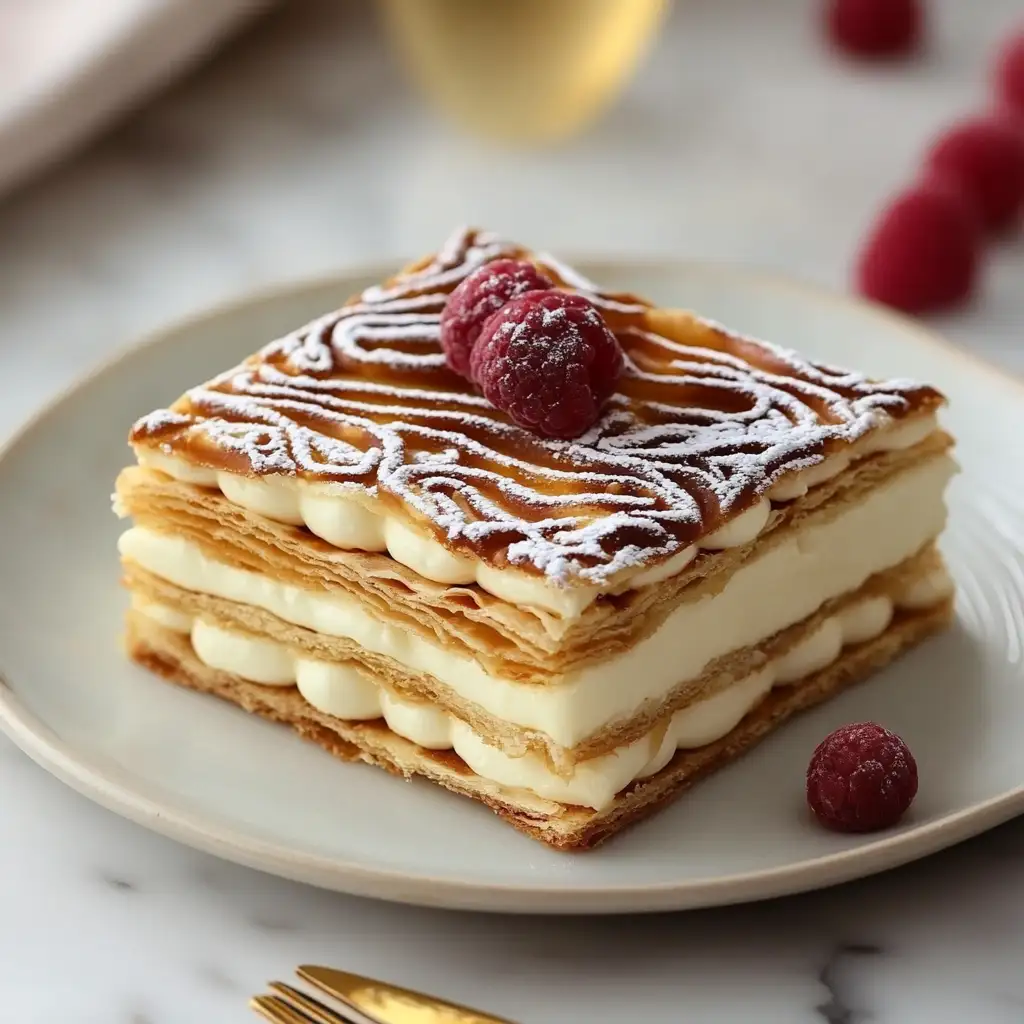Description of this recipe:
The Mille-Feuille, French for “thousand leaves,” is a classic dessert that embodies elegance and deliciousness. This recipe provides a step-by-step guide to creating this iconic pastry, featuring flaky puff pastry layers, a rich and creamy crème pâtissière, and a delicate feathered icing. It’s a showstopper that will impress your friends and family, proving that homemade desserts can be both beautiful and incredibly satisfying.
Why you will love this recipe:
This Mille-Feuille recipe is a journey into the heart of French pastry. You’ll love the way the crisp, buttery puff pastry crumbles in your mouth, perfectly complementing the smooth and luscious pastry cream. The feathered icing adds a touch of visual flair, making it a dessert that’s as pleasing to the eye as it is to the palate. While it requires some time and attention, the result is a rewarding masterpiece that’s far superior to anything you can buy in a store. This recipe allows you to customize the flavors and presentation, making it uniquely your own.
Ingredients:
For the Pastry Layers:
- 1 lb (450 g) puff pastry (store-bought or homemade)
- Powdered sugar (for dusting)
For the Pastry Cream (Crème Pâtissière):
- 2 cups whole milk
- 1 vanilla bean (or 1 tsp pure vanilla extract)
- 5 large egg yolks
- ½ cup granulated sugar
- ¼ cup cornstarch
- 2 tbsp unsalted butter
For the Icing & Decoration:
- 1 cup powdered sugar
- 2–3 tbsp water (adjust for consistency)
- ¼ cup melted dark chocolate (for feathering pattern)
Preparation:
The preparation of a Mille-Feuille is an art, a delicate dance of layering and flavors. Each step is crucial to achieving the perfect balance of textures and tastes. Here’s how to bring this classic to life:
Step 1: Preparing the Puff Pastry
Begin by preheating your oven to 400°F (200°C). The temperature is key to ensuring the puff pastry rises properly, creating those signature layers. On a lightly floured surface, gently roll out the puff pastry into a large rectangle, aiming for about ⅛ inch in thickness. Even thickness is important for even baking.
Step 2: Baking the Puff Pastry
Carefully transfer the rolled-out pastry onto a baking sheet lined with parchment paper. Now, the critical step: prick the pastry all over with a fork. This prevents excessive puffing, ensuring the layers remain defined and the pastry stays relatively flat. Place another sheet of parchment paper on top of the pastry, followed by a second baking tray. This “sandwich” method is crucial for keeping the pastry flat during baking.
Step 3: Baking Time
Bake the pastry for 15–20 minutes, or until it’s a beautiful golden brown. Keep a close eye on it; ovens can vary. Remove the top tray and parchment paper for the last 5 minutes of baking. This allows the pastry to crisp up fully, adding that delightful crunch to the finished Mille-Feuille.
Step 4: Cooling and Cutting
Once baked, let the pastry cool completely on a wire rack. Patience is key here; warm pastry is difficult to handle. Once cooled, use a sharp serrated knife to carefully cut the large rectangle into three equal rectangles. This precision ensures that your Mille-Feuille will have uniform layers.
Step 5: Making the Pastry Cream: Infusing the Milk
In a medium saucepan, heat the whole milk along with the split vanilla bean (or vanilla extract) over medium heat. If using a vanilla bean, scrape the seeds into the milk for maximum flavor. Heat until the milk is just steaming, but not boiling. This infuses the milk with the rich aroma of vanilla.
Step 6: Preparing the Egg Yolk Mixture
In a separate bowl, whisk together the egg yolks, granulated sugar, and cornstarch until the mixture is pale and smooth. This step is crucial for creating a lump-free pastry cream. The cornstarch acts as a thickener, giving the cream its characteristic texture.
Step 7: Combining and Cooking the Cream
Slowly pour the hot vanilla-infused milk into the egg yolk mixture, whisking constantly to prevent the eggs from cooking. This gradual incorporation is key to a smooth, emulsified cream. Return the mixture to the saucepan and cook over medium heat, whisking continuously. The whisking is vital to prevent scorching and to ensure even thickening. Continue cooking until the cream is thick, glossy, and bubbling.
Step 8: Finishing the Pastry Cream
Remove the saucepan from the heat and stir in the unsalted butter. The butter adds richness and shine to the pastry cream. Transfer the cream to a bowl and cover the surface directly with plastic wrap. This prevents a skin from forming as the cream cools. Refrigerate the pastry cream until it is completely cool.
Step 9: Assembling the Mille-Feuille: First Layer
Now comes the fun part: assembly. Place one puff pastry layer on a serving platter. Spread half of the cooled pastry cream evenly over the pastry layer. Use an offset spatula to ensure an even distribution.
Step 10: Second Layer
Gently place the second puff pastry layer on top of the cream. Spread the remaining pastry cream evenly over this layer.
Step 11: Final Layer
Place the final puff pastry layer on top.
Step 12: Making the Icing
In a small bowl, whisk together the powdered sugar and water until you achieve a smooth icing consistency. Add the water gradually, as you may need more or less depending on the humidity.
Step 13: Decorating the Mille-Feuille
Spread the icing evenly over the top layer of the Mille-Feuille.
Step 14: Creating the Feathered Pattern
Drizzle parallel lines of melted dark chocolate across the icing. Use a toothpick to drag perpendicular lines through the chocolate, creating the classic feathered pattern. Get creative with your design!
Step 15: Chilling and Serving
Chill the assembled Mille-Feuille for 1–2 hours before slicing. This allows the layers to set and the flavors to meld. Use a sharp, serrated knife to slice the Mille-Feuille for clean, even layers.
COOKING Rating: Intermediate
Serving Suggestions:
- Serve chilled as a dessert.
- Pair with fresh berries or a scoop of vanilla ice cream.
- Enjoy with a cup of coffee or tea.
Tips:
- For extra crisp layers, bake the puff pastry ahead of time and store it in an airtight container until ready to assemble.
- Use high-quality chocolate for the feathered pattern.
- If you’re short on time, use store-bought pastry cream.
- Don’t be afraid to experiment with different flavor combinations in the pastry cream, such as lemon or coffee.
- The key to a perfect Mille-Feuille is patience and attention to detail.
Prep Time: 45 minutes
Cook Time: 20 minutes
Total Time: 1 hour 5 minutes (plus chilling time)
Nutritional Information: (per serving, approximate)
- Calories: 450
- Protein: 8g
- Sodium: 200mg
Conclusion
The Classic Mille-Feuille is a testament to the beauty and artistry of French pastry. While it may seem intimidating at first, this recipe breaks down the process into manageable steps, allowing you to create a stunning and delicious dessert in your own kitchen. With its layers of flaky pastry, creamy filling, and elegant decoration, the Mille-Feuille is sure to impress and delight anyone who tastes it. So, gather your ingredients, follow the instructions, and prepare to embark on a culinary adventure that will leave you with a newfound appreciation for the art of pastry making. Bon appétit!
Questions and Answers about the Classic Mille-Feuille Recipe:
Q1: Can I use homemade puff pastry instead of store-bought?
A: Absolutely! Homemade puff pastry will elevate the Mille-Feuille to an even higher level. However, making puff pastry from scratch is a time-consuming process, so ensure you have ample time and patience. If you choose to make your own, be sure to follow a reliable recipe and keep the butter cold throughout the process to achieve those distinct layers.
Q2: What can I substitute for the vanilla bean in the pastry cream?
A: If you don’t have a vanilla bean on hand, you can substitute 1 teaspoon of pure vanilla extract. Add the extract to the pastry cream after it has been removed from the heat, along with the butter. While vanilla extract provides a good flavor, using a vanilla bean will impart a more complex and aromatic taste to the cream.
Q3: My pastry cream is lumpy. How can I fix it?
A: Lumpy pastry cream can be caused by improper whisking or cooking the eggs too quickly. If your pastry cream is lumpy, try passing it through a fine-mesh sieve to remove any lumps. Alternatively, you can use an immersion blender to smooth out the cream. Be careful not to over-blend, as this can make the cream too thin.
Q4: How can I prevent the puff pastry from puffing up too much during baking?
A: To prevent excessive puffing, it’s crucial to prick the puff pastry all over with a fork before baking. This allows steam to escape, preventing the pastry from rising too much. Additionally, baking the pastry between two baking sheets helps to keep it flat.
Q5: Can I make the Mille-Feuille ahead of time?
A: While the puff pastry can be baked ahead of time and stored in an airtight container, it is recommended to assemble the Mille-Feuille no more than 24 hours before serving. The pastry layers can become soggy if they sit for too long with the pastry cream. For the best results, assemble the Mille-Feuille a few hours before serving to allow the flavors to meld.

